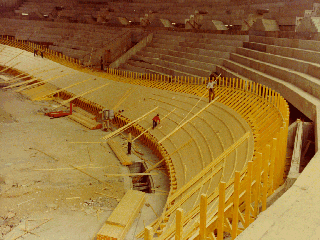
|
|
|
|
| SCHUERMANN ARCHITECTS * Schuerbusch 26 * 48163 Muenster * Germany |
| CYCLE TRACKS |
| Technical Information |
| Definitions | |
| Cycle track | The track, the cycling surface itself, including it's
subconstructions, the "Côte d'azur" and the balustrade..
From the inside of the "Côte d'azur" to the outside of the "balustrade" |
| Velodrom(e) | The venue in which the "cycle track" is installed.
The velodrome includes the infield, the safety area, the tunnel, possible grandstands, changing rooms etc. |
| home straight
back straight |
The two straight elements of a "cycle track".
Home straight = straight, where the "finish line" is situated. Back straight = straight opposite the "home straight" |
| curve / bend | The curved elements of a cycle track.
There are two bends covering each a 180 degree turn in direction. The are no -(or at least should not be)- "corners" in a track. |
| Length | The circumference of a track on the measuring line. |
| Width | The distance between "Côte d'azur" and balustrade.
The width shall be continuous all around the track. |
| measuring line | A black or white line (depending on the basic surface colour) determining the length of a track. |
| sprinters line | A red line (90 cm above the "Côte d'azur") indicating
the sprinters-corridor.
If a rider is positioned inside this corridor (between "Côte d'azur" and sprinters-line), he may not be overtaken on the left. |
| stayers line | A blue line (at 1/3 of the track width, but at least
2,50 m above the "Côte d'azur") indicating the corridor, in which
the stayer has to ride when being attacked from behind.
In Madison races serving as the lower border of the "resting zone" for the relieved riders. |
| Côte d'azur | (French=blue coast, pronouce maybe:
"Code da ssur", also called "blue band")
A light blue painted area inside the cycle track serving to access the real track surface. Not a part of the official cycling surface. |
| Finish-line | A white band with a central black line all across the track width serving as the finish for all disciplines except "pursuit". |
| Pursuit lines | A red line at each center of the straight lines serving as the start and finish line for "pursuit"-races. |
| 200 m-line | A white line all across the track width indicating the distance of 200 m until the "finish line" |
| Balustrade | The outer limit of the track, consisting of a solid, closed low wall and a railing. |
| Safety area | A band of 2,50 m to 4,50 m width inside the "Côte d'azur", which has to be kept free of all obstacles. Serving as a "safety room" in case of accidents. |
| What is a cycle track ? | |
| A cycle track in general is an installation, on which
(track) cycling sport may be performed. It allows to perform longer distance
racing on a smaller area and in one loaction.
A cycle track consists in general of two straight elements and two curved elements, covering each 180° degrees, which turn the riders in their opposite direction of riding. While moving with a certain speed in a bend nature is
producing centrifugal resp. centripetal forces. These forces have to be
considered by the track geometry in order to enable the riders to maintain
their riding line and speed.
Since the cycling sport, the performance of the riders
and the used materials (bicycle, clothing etc.) are in a constant development,
the track design has to answer on such developments and to adapt the design
criteria according to the progress.
|
| Track
lengths |
|||||||||||||||||||||||||||||||||||||||||||||||||||||||||||||||||||||||||||||||||||||||||||||||||||||||||||||||||||||||||||||||||||||||||||||||||||||||||||||||||||||||||||||||||||||||||||||||||||||||||||||||||||||||||||||||||||||||||||||||||||||||||||||||||||||||||||||||
| In general there are no fixed standards for the length
of a track. The track has to be individually designed in order to suit
the demands of the respective project.
The choice of the track length and it's form will be influenced by the intended use, the category of track desired and economical aspects. In practical terms the choice of a track length should be such, that the multiplication of half -or preferably- full laps, will result in a round figure of 1'000 meters. Shorter tracks are spectator-friendly.
If professionally designed, such smaller tracks offer
generally the same possibilities for the riders to perform their sport.
Although being steeper inclinated, such shorter track will not produce
more difficulties or dangers. They have to -just as the longer tracks-
be in perfect harmony with the laws of physics and track cycling, but will
just be far more attractive.
|
|
|
|
|
 |
|
|
| But if you should nevertheless have urgent questions |
| - about sizes and proportions of cycle tracks |
| - about materials and building principles |
| - about costs and building times |
| - or other |
|
|
|
|
|
|
|
|
|
|
|
|